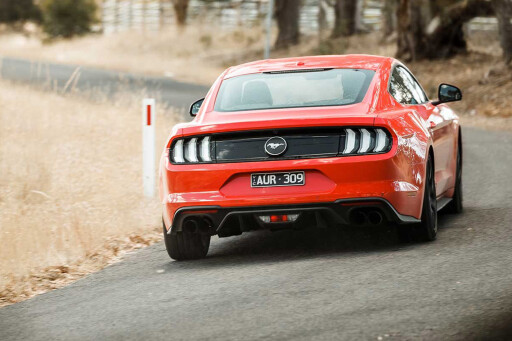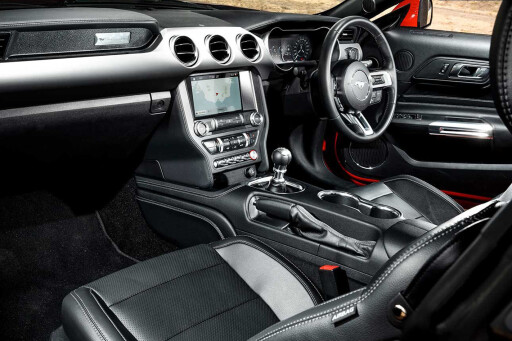
What is it?
Possibly one of the most controversial and polarising Mustang variants to date.
Since the inception of the pony car in the 1960s, the Mustang has been powered at the flagship end of the range by a V8 - as it is to this day.
But during its half-century lifetime, a number of other engine options have been offered for those looking for the quintessential Mustang aesthetics on a tighter budget.
A bargain-basement V6 didn’t make it to Australia for the sixth-generation but the EcoBoost did and it was retained as part of a significant 2019 update. Purists will instantly dismiss a four-cylinder Mustang but should you?

How much is the Ford Mustang EcoBoost?
No matter which variant you pick from the line-up, the Mustang is priced very attractively, despite range-wide increases for the 2019 facelift.
For a start, the GT kicks off at $62,990 which is a steal. What other model offers rear-drive, manual fun with V8 power and those looks? But if you think that’s good then wait until we look at the most affordable version.
At $49,990, the EcoBoost manual is unrivalled even in Australia’s incredibly diverse new car market, and you’ll struggle (most likely fail) to find anything that does the job for the same cash.
Mazda will sell you its much smaller and less powerful 2.0-litre MX-5 for about $42,000 and the equally diminutive Subaru BRZ and Toyota 86 fraternal twins cost about $35,000 but they’re hard to compare to an American muscle car.
In fact, the only thing even close is the Mustang’s arch-rival Chevrolet Camaro, which is imported by HSV and converted to right-hand drive in Melbourne. It’s only available as a V8 auto only and the complex local engineering pumps the price to a whopping $85,990.

Who is the Ford Mustang EcoBoost for?
You won’t find a diehard Mustang enthusiast jumping into a four-cylinder EcoBoost any time soon and the vast majority of sales in Australia have been for the V8 GT, but there is still a place for the most affordable version.
If you simply love the way the Mustang looks or have a budget that won’t stretch to a V8, and you don’t need outright tyre-destroying performance, then the EcoBoost is virtually indistinguishable from the GT. Only a close look at the boot and side badging reveals what's under the bonnet.
But there is another type of customer that it should also appeal to as well. It might have half as many cylinders and a little less power, but the EcoBoost is certainly not slow and has a weight and handling advantage over the V8.
Don’t think that opting for the four-pot means you’re getting a boring car to drive. The EcoBoost is for driving enthusiasts too.

Is the Ford Mustang EcoBoost easy to live with?
Yes, very. The Mustang, regardless of the variant, is an aspirational sportscar but it’s a sports car built by Ford and that means all of the dependability and features you might expect to find in one of the many other Blue Oval passenger and SUV models.
There’s the company’s Sync3 information and entertainment system that offers a beautifully intuitive 8.0-inch touchscreen system and up-to-the-minute technology including Android Auto/Apple CarPlay smartphone mirroring and navigation.
But, while the GT has eight cylinders to feed, the EcoBoost has just four and that will show at the bowser.
The Mustang received lots of unwanted publicity in 2017 when it scored a surprisingly low two-star safety rating in ANCAP testing. However, the company has added important safety features for the update including forward collision mitigation technology and lane departure monitoring, which has helped elevate that rating to three stars. Still not great, but the main contributor to that score - rear-occupant safety - is probably not of great concern to a vast majority of owners.
If you try to use the rear seats, you’ll probably understand why as well. Approaching the Mustang as a two-seater with the ‘rear seats’ providing even more storage in addition to the decent boot is probably the most sensible strategy.

How well does the Ford Mustang EcoBoost drive?
Before we look at all of the EcoBoost’s virtues - and there are many, let’s briefly acknowledge the elephant in the room then move on.
While there is certainly a performance shortfall - the 2.3-litre four-cylinder’s 224kW is some way behind the 339kW of the 5.0-litre GT - perhaps the greatest loss is its soundtrack.
We certainly can’t deny that the sound of the Coyote V8 is the perfect match for a Mustang and we can totally understand that, for many Australians, the noise is worth the extra investment alone.
But that’s not to say the four-cylinder sounds bad. On the contrary, a new bimodal sports exhaust is loud and wholesome and has a report not unlike the Ford Focus RS, which has an engine closely related to that in the Mustang.
Unlike the V8, the EcoBoost is turbocharged and that means a majority of low-rev pulling power comes in rapidly and without fuss. This makes the EcoBoost feel rapid off the mark and not far behind the GT.
But while the big 5.0-litre V8 loves to spin all the way to the redline, the four-cylinder is all done before 6000 rpm. There are some strange gaps in the power delivery throughout the rev range and piloting the four-cylinder requires a completely different approach to the V8, but get it right and the most affordable ‘Stang can be a seriously quick machine.
And for those concerned about traditions, don’t forget that the third-generation Mustang was also offered with a 2.3-litre turbocharged four-cylinder, so there’s heritage linearity there too.
The ten-speed automatic will cost you an extra $3000 and is frankly a little disappointing with lacklustre shift urgency and a constant hunt for higher gears, but the six-speed manual in our car is delightful. Mechanical and solid with short and precise shifts that adds to the rewarding and involved driving experience.
Look beyond the engine, however, and the news gets even better. With four fewer cylinders to cart around, the EcoBoost is not only lighter, but its weight is distributed more effectively too. Tip the nose into a fast corner and the EcoBoost is immediately more obedient and responsive, complemented by little body roll and an eagerness to change direction.
While a heavy hand can provoke understeer in the GT with so much weight up front, the four-pot is unapologetically about neutrality followed by oversteer at the limit.
The lower kerb weight comes across in all driving too with an ability to punish the brakes harder and deeper into corners, the ride feels more compliant over poor surfaces.
The whole car simply feels less stressed and less highly strung.
Verdict
From almost every angle, the EcoBoost appears to make more sense than the GT. It’s cheaper, more efficient, lighter, has sweeter handling and wears exactly the same handsome looks as the eight-cylinder.
But it lacks the full-fat 5.0-litre power of the GT and the gorgeous soundtrack that accompanies it and, for most Mustang intenders, that’s a deal breaker.
Set your traditionalist aspersions aside, though, and the Mustang EcoBoost is a performance car bargain that does not deserve mockery. The turbo four-pot sound is unconventionally satisfying, acceleration is strong, its road-holding is excellent and there’s simply nothing else to compare under $50,000.
If the GT is a flighty thoroughbred then the EcoBoost is a more approachable pack pony that can still gallop when it needs to but will never buck you off.


COMMENTS